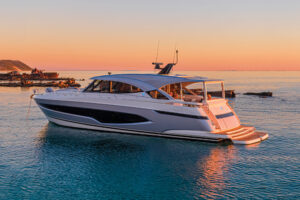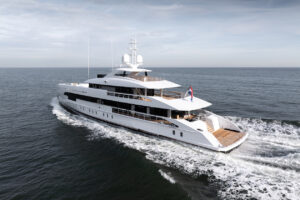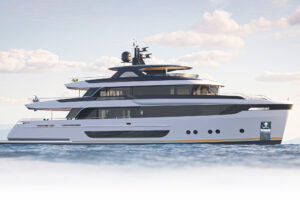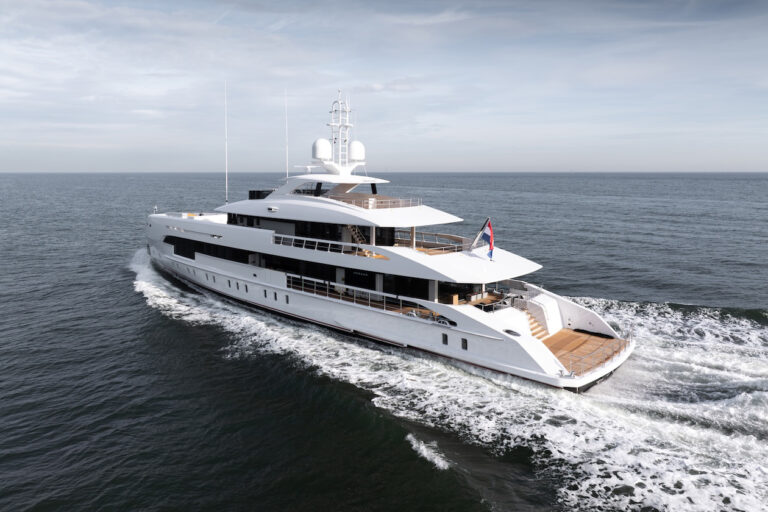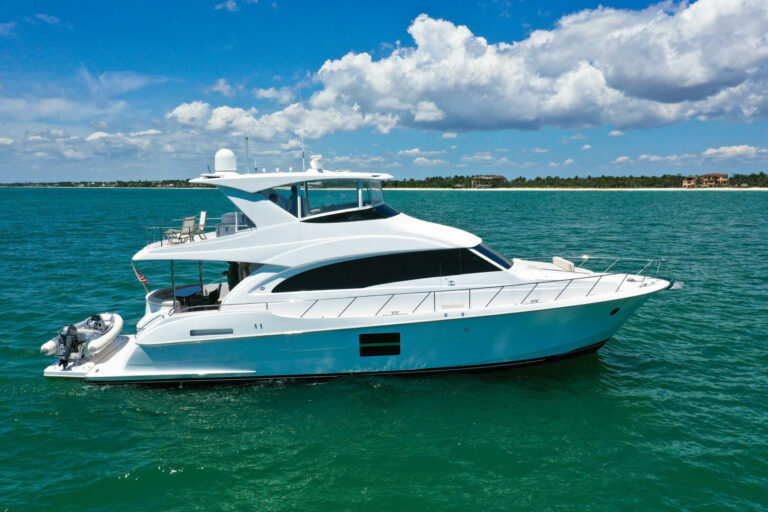It seems like yesterday when I wrote about a new boat and a new company that were challenging the American standard (actually the June 1994 issue of Yachting). Then the boat was a 76-footer built by Lazzara Yacht Corporation. While the company can no longer be branded an upstart, its new 68-footer is proof that brothers Brad and Dick Lazzara are still thinking out of the box. Even back then the Lazzara name wasn’t new to boating. Brad and Dick’s father, Vince, helped pioneer large fiberglass yacht construction. Today, Brad focuses on business and Dick oversees the creative and technical aspects of yacht building. In 1994 I respectfully labeled Dick a dreamer. His approach to problem solving was, in his own words, “risky.”
Back in the 1990s U.S. production boatbuilders were slow to respond to the growing numbers of yachtsmen who found the stylish, high performance motoryachts arriving from Europe appealing. For Lazzara, preparing to launch a boat and a company, the Euro Invasion was a blessing. “The acceptance of Italian yachts in the U.S. in a sense endorsed what we were trying to achieve from a styling and performance standpoint,” says Dick. And challenging the status quo has paid off big: To date Lazzara has delivered 100 yachts from 68 to 110 feet.
The difference was that Lazzara’s 76-footer was designed specifically for Americans. “Americans prefer flush-deck motoryachts the ability to walk from stem to stern without stubbing a toe,” Dick says. “The trick was coming up with a design that didn’t appear boxy or old fashioned.”
Ten years later the goal for the 68 is much the same. Fans of the brand will find she shares the shape and feel common to the family. Her superstructure cascades aft, terminating in a winged arch. A shark-fin window design is complemented by an integral bulwark aft that forms an air intake plenum and blends with her reverse sheer and transom. Hullside windows provide a unique accent and natural light below deck.
Almost all the buyers of the 76 were owner-operators moving up from express cruisers, and Lazzara expects the same will be true for the 68. “These folks are used to taking the wheel and 68 feet can be a lot of boat, so ease of operation was a primary consideration in the design,” says Dick. An afterdeck control station hidden in a cabinet is designed to facilitate docking stern-to, and bow and stern thrusters are standard.
The flying bridge has a full control station with helm and companion seating. Exterior public areas are at a premium in Lazzara’s designs, so there is a semicircular seating area aft with tables, a wet bar and a built-in grill. A stylish fiberglass hardtop offers protection; but there are the adjustable sun lounges aft.
All this is possible because the boat deck is below. “Americans want a large flying bridge and easy access to their water toys, and transom garages are the solution,” Dick says. The 68 can accommodate a 10-foot water jet-equipped rigid bottom inflatable. The teak-covered afterdeck has a built-in seating area. A flat-screen TV is mounted to the overhead in a watertight case that can be rotated for optimum viewing. Imagine enjoying cocktails and dining alfresco with the ballgame in overtime.
Unlike some European designs where built-in joinery can create an obstacle course, the 68’s saloon is open and casual, with a puffy sofa, a well-endowed entertainment center and a dining area. An open galley area and lounge are forward adjacent to the interior helm station. The interior access to the flying bridge is steps away from the helm. Stairs in the saloon lead below to a full-beam master suite with a king-size berth and two guest staterooms with full-size berths and private heads. Stairs forward lead to a “media room” and a third guest stateroom with upper and lower berths and a private head. The accommodation spaces are finished with Makore cherry cabinetwork, stone and high quality soft goods and fixtures all a dreamer could desire.
In the 1990s, the 76 project took 18 months to complete. At the time CAD/CAM (computer aided design and manufacturing) and CIM (computer integrated manufacturing) were little more than high-tech buzzwords in the marine industry. Lazzara employed these technologies in the design office and on the shop floor at the start and has profited over the years as the process has matured. The 68’s female tooling was cut with a 5-axis router and her interior was modeled in 3-D and cut by computer. The net result: Creating the 68 took half the time.
The 68 is laid up by hand with stitched multidirectional reinforcements and vinylester resin. Balsa coring is used in the hull, decks and flying bridge and is vacuum-bagged in place. The hull is supported by a fiberglass stringer system and balsa-cored fiberglass bulkheads, all cut by computer. An admirer of W. Edwards Deming, the American who taught the Japanese to build cars in the 1950s, Lazzara sees boatbuilding more as a process of “assembling parts.” While the fiberglass parts are laid up, the interior is built on a jig on the shop floor. When complete, the entire interior is lowered into the hull before the superstructure is fitted.
The 68’s machinery space is laid out with access in mind. “While Europeans avoid the engineroom, Americans take pride in it,” says Dick. A watertight door allows access from the garage and there is alternate access from the main deck. A workbench has a toolbox and enough shelf space for a full assortment of spare parts and filters. Bilges are decked over with removable panels and the compartment is finished with epoxy. Intake air plenum fire dampers and a three-zone emergency de-watering system are examples of features that have trickled down from Lazzara’s larger projects. Lazzara’s ISIS (Integrated Ships Information System), introduced aboard the first 76, is standard equipment on all of the builder’s products. ISIS monitors ship’s systems from bilge pumps to oil pressure and records these vitals every 60 seconds. Downloaded from every boat in the fleet, this data serves as a valuable problem-solving tool.
The 68’s hull form was developed in-house. Hard chines define a moderate entry forward and a modest deadrise (approximately 14 degrees) at the transom. Propeller pockets allow for a draft of just 4 feet, 2 inches. Lazzara’s data indicates that the standard 1,000 hp Caterpillar, C-18s deliver a top speed of 29 knots and a cruising speed of 26 knots.
“While most builders seem focused on building larger and larger boats, we have chosen not to abandon the market that put us on the map,” says Dick Lazzara. Apparently Brad and Dick’s vision is still clear, as the company’s investment in the 68 is paying off: Production is sold out through 2005.
Contact: Lazzara International Yacht Sales, (813) 835-5300; www.lazzarayachts.com.

